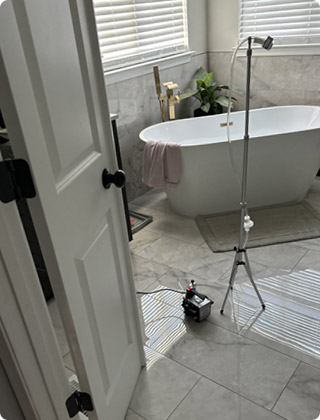
Bathroom Mold: How Professional Testing Can Identify Hidden Issues
Your bathroom: a place for hygiene and relaxation. But beneath the steamy showers and running faucets, a hidden threat might be thriving - mold. While you might diligently scrub away visible mildew, mold can lurk in unseen corners, posing risks to your health and your home's structural integrity.
Our team of certified mold experts understands that not all mold issues are obvious. This post will delve into why bathrooms are so susceptible to hidden mold, discuss some of the common types you might encounter, and explain how professional testing can uncover these issues, ensuring a healthier and safer environment for you and your family.
The Perfect Environment For Mold Growth In Bathrooms
Bathrooms unfortunately create the perfect storm for mold growth due to several key factors. The high humidity generated by showers, baths, and even just running the tap provides the moisture that mold spores need to flourish. Additionally, the frequent use of water increases the likelihood of leaks and overall moisture buildup in the environment.
Often, poor ventilation in bathrooms traps this moisture, preventing it from dissipating and creating a consistently damp atmosphere. Finally, common organic materials found in bathroom construction, such as drywall, wood, and even some paints, serve as a food source for mold.
Common Hidden Spots For Bathroom Mold
While you might readily spot mold on grout or shower curtains, it frequently establishes itself in less obvious locations. Consider areas behind tiles, where cracks in grout or sealant can allow water to seep in, creating a dark and moist environment. Mold can also thrive under sinks due to leaky pipes or condensation accumulating on the cabinet floor and surrounding walls.
Furthermore, inside walls, particularly around plumbing, water leaks can occur and fuel extensive mold growth without any visible surface indicators. Don't overlook exhaust fans, where dust and moisture combine to provide a surface for mold to grow and potentially circulate spores. Even around windows, condensation can lead to mold growth on the frames and adjacent drywall, and under flooring, water damage or persistent high humidity can foster mold development beneath vinyl or tile.
Types Of Mold Found In Bathrooms
Several types of mold commonly thrive in the damp environment of a bathroom:
- Aspergillus: This is a very common type of mold that can appear in various colors, including green, black, and brown. It often grows in damp areas and can trigger allergic reactions and respiratory issues.
- Cladosporium: This mold is often black or green and can grow in both warm and cool damp areas. It's frequently found on shower surfaces, tiles, and grout. Cladosporium can also cause allergic symptoms.
- Penicillium: Typically blue-green in color, Penicillium is another common household mold that can be found in water-damaged areas in bathrooms. Some species can produce mycotoxins and trigger allergic reactions.
- Stachybotrys Chartarum (Black Mold): While less common in bathrooms than the other types, black mold can grow in areas with significant water damage and high humidity over extended periods. It's often associated with more serious health concerns.
- Serratia Marcescens (Pink "Mold"): Not a true mold but a bacteria, this pink-orange slimy film frequently appears on shower walls, around drains, and in toilet bowls. It thrives on mineral deposits from soap and hard water. While less dangerous than toxic molds, it can cause urinary tract infections and respiratory irritation, particularly in immunocompromised individuals. Its presence signals excessive moisture that could lead to actual mold growth.
- Alternaria: This mold is usually dark in color (brown or black) and can be found in damp areas like showers and under sinks. It's a common allergen.
It's important to note that while you might be able to visually identify the color of some mold, professional testing is the only way to accurately determine the specific types of mold present.
Signs You Might Have Hidden Mold
One of the first signs of hidden mold can be a persistent musty odor, even if you meticulously clean. This smell indicates microbial growth, even if you can't see it because it is behind walls, under floors, or in other concealed spaces. In some cases, hidden mold might only manifest as subtle staining or discoloration on walls or ceilings, without forming a clear, defined mold colony.
Check for physical signs, like peeling paint, warped walls, or bubbling wallpaper. These often point to trapped moisture, which encourages mold growth. Discolored grout, dark spots on caulk, or a damp, spongy feel around tiles can also indicate hidden mold.
Do you or your family experience unexplained allergy symptoms - sneezing, itchy eyes, congestion, or worsened asthma - especially when using the bathroom? Mold spores could be the hidden trigger. Symptoms that improve when you leave the house are a strong sign of an indoor mold issue.
How O2 Mold Testing Uncovers These Issues
Even minor, slow leaks from pipes, showers, or sinks can create the perfect environment for mold. Don't wait for visible growth - early detection prevents bigger problems.
Professional mold testing goes beyond a simple visual assessment to uncover these hidden issues. At O2 Mold Testing, we employ various methods to accurately identify the presence of concealed bathroom mold. Air sampling allows us to determine the type and concentration of mold spores present in the indoor air. Elevated spore counts can strongly suggest hidden mold growth, even without visible evidence.
Surface sampling allows us to take physical samples from specific areas, such as behind tiles or within exhaust fans, to directly confirm the presence of mold and identify the specific species. We also utilize moisture meters to detect elevated moisture levels within walls, floors, and ceilings, which can point to areas conducive to hidden mold development. In certain situations, thermal imaging can be a valuable tool to identify temperature variations that might indicate moisture intrusion and potential mold growth behind surfaces.
The Benefits Of Professional Mold Testing
When it comes to hidden bathroom mold, professional mold testing is a critical first step. It helps uncover what you can't see - mold growing behind walls, under flooring, or inside ventilation systems. By identifying these concealed sources early, you're able to take swift action before the problem gets worse.
Pinpointing mold through testing doesn't eliminate the issue on its own, but it lays the groundwork for proper remediation. Once you know exactly where mold is hiding and how severe the growth is, you can address it effectively - often preventing structural damage to drywall, wood, and insulation before it becomes a costly repair.
Testing also helps protect your health. Mold exposure has been linked to allergy flare-ups, respiratory irritation, and other health concerns. By identifying and removing hidden mold, you can improve indoor air quality and create a noticeably cleaner, healthier home environment. And most importantly, knowing your bathroom has been thoroughly inspected gives you peace of mind that you're not living with a hidden health hazard.
Take Action: Identify Bathroom Mold Today
Don't let hidden mold compromise the health and safety of your home. If you suspect mold growth in your bathroom, even if you can't see it, professional testing from O2 Mold Testing is the key to uncovering these hidden issues and identifying the specific types of mold present.
Our comprehensive testing methods will provide you with the information you need to take effective remediation steps. Breathe easier and protect your property - contact O2 Mold Testing today for a thorough bathroom mold assessment. Call us at 888-202-1680 to schedule your testing.
Proactive Steps For A Mold-Free Bathroom
Bathroom mold is a common problem, and often the most concerning issues are the ones you can't see. By understanding the conditions that promote mold growth, the common types of mold that thrive in bathrooms, and the hidden areas where it can flourish, you can be proactive in protecting your home.
Professional mold testing from O2 Mold Testing offers a reliable way to identify these hidden threats and the specific species involved, allowing you to address them effectively and ensure a healthy and safe bathroom environment for years to come.


